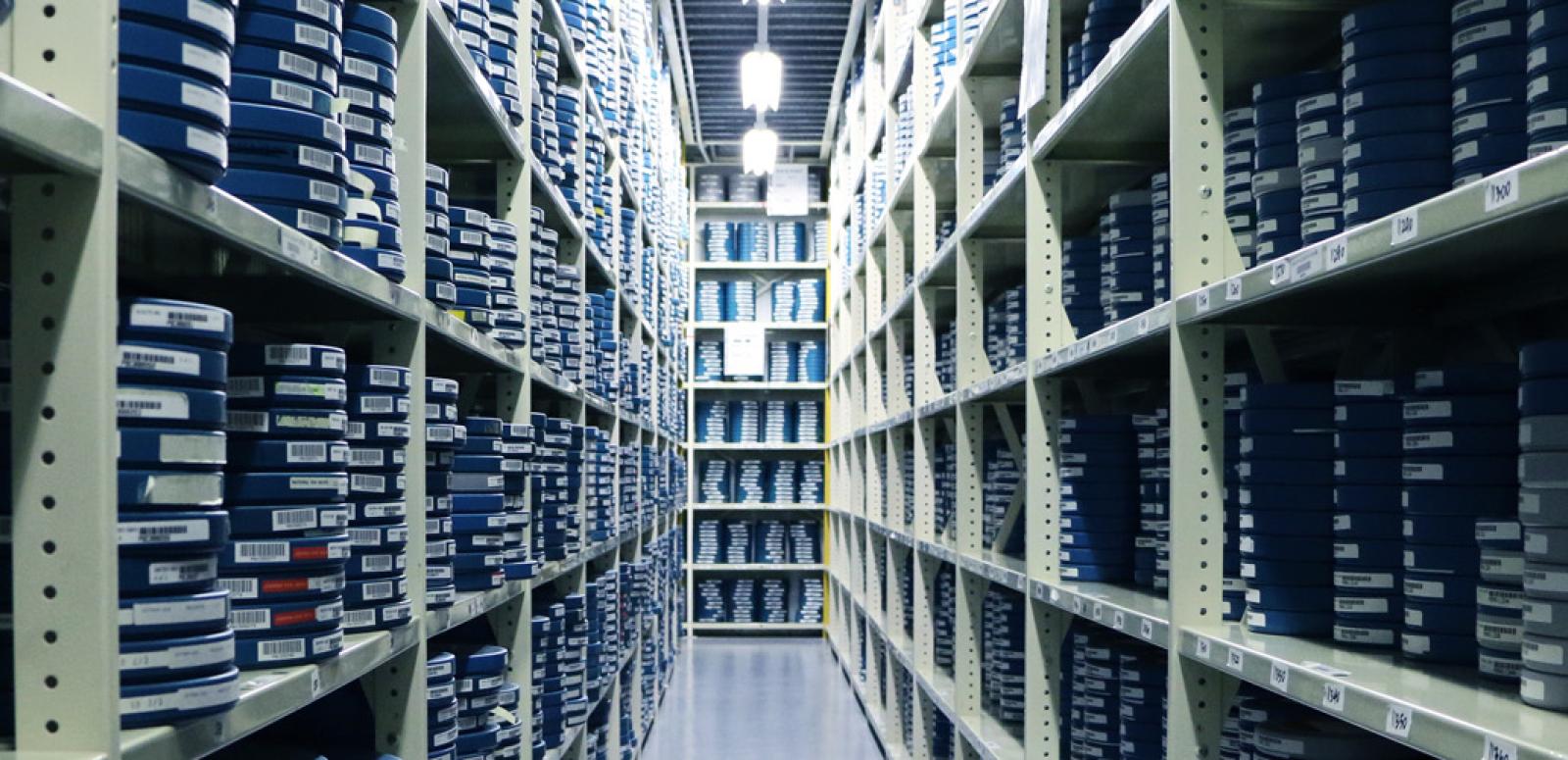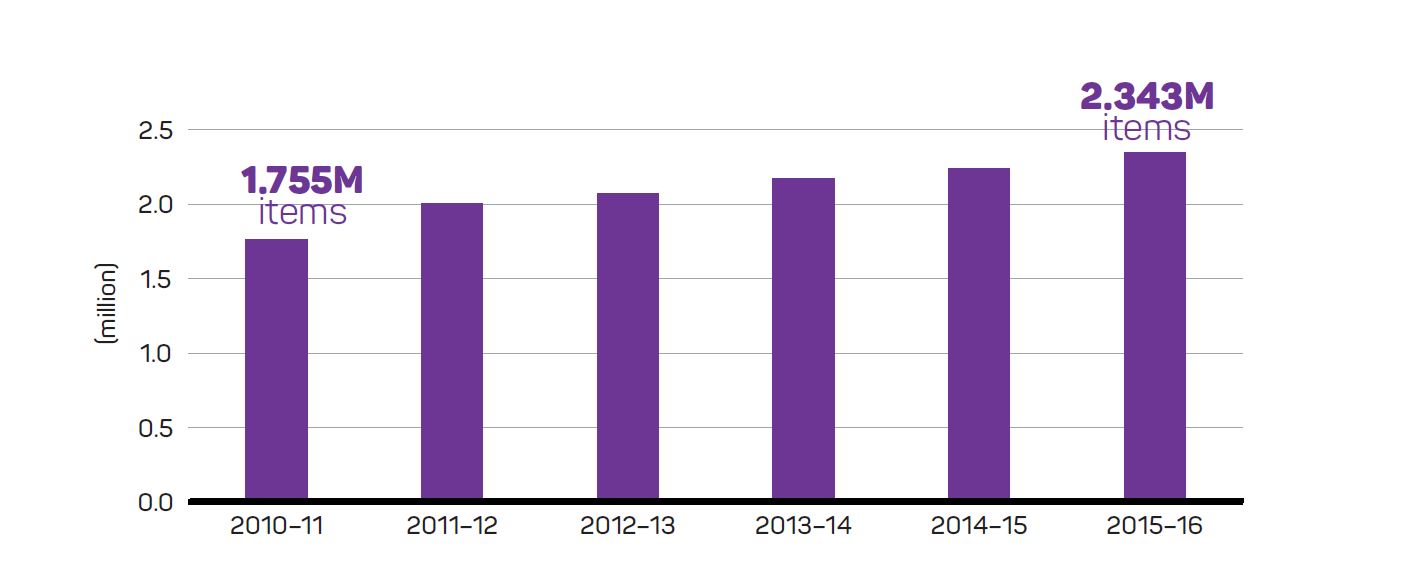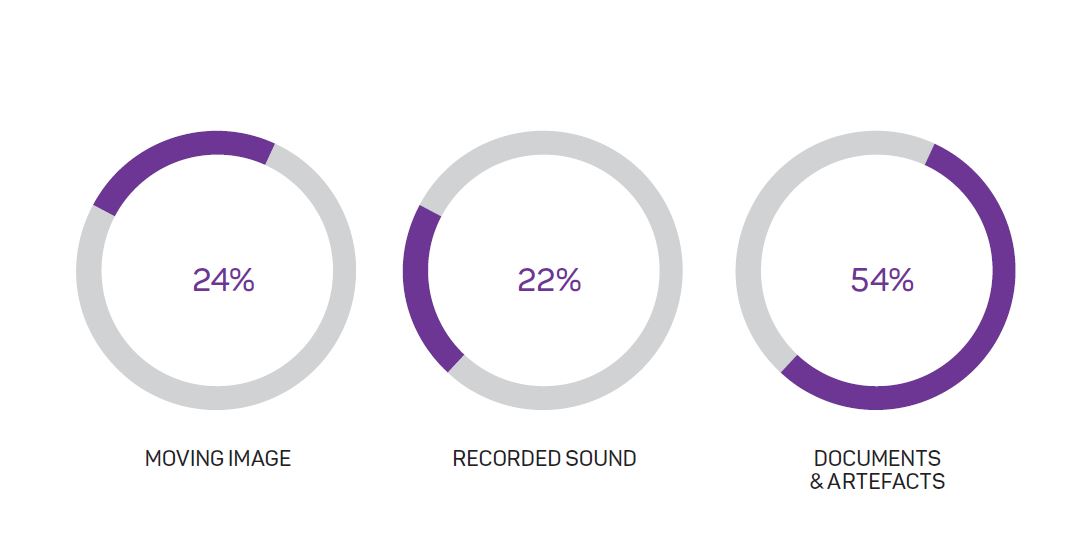

Annual Report 2015-16
Purpose 1: Developing the Collection
At the core of our activity is developing a national audiovisual collection to the highest curatorial standards, as guided by our Collection Policy. At 30 June 2016 our collection comprised approximately 2.343 million items, of which 54% were documents and artefacts, 22% were recorded sound and 24% were moving images (see figure 2 and figure 3).

Collection growth, 2010–11 to 2015–16

Percentage breakdown of the collection 2015–16
Results: Developing the Collection

Pathway 1.1.1 ACQUISITIONS
We continue to develop and maintain a collection of materials that has enduring cultural significance. During the year we acquired 435 documentaries, 402 feature length films, 714 short films, 350 small gauge films, 31,084 documents and artefacts, 48,542 sound recordings, 4,903 radio works, 5,966 television works and 61 oral histories. (see table 1 on page 18).
Acquisition highlights for the year are listed at appendix 3.
| Criterion source: Program 1.1, 2015–16 Portfolio Budget Statements page 376, 2015–16 Corporate Plan page 4, cross-agency performance indicator |
| Strategic Priority 1: A ‘living’ archive – for everyone |

Pathway 1.1.2 ACCESSIONING
Over the past five years we have consistently exceeded our accessioning target by a substantial margin. This is due to a number of factors, including the regular reviews we have undertaken of our accessioning processes to become more efficient and streamlined. More significantly, we have made improvements to functionality in managing digital content in our collection management system, Mediaflex. Increasingly, we are receiving incoming acquisitions in digital formats. When accessioning born-digital material, Mediaflex’s workflows automatically generate the requisite three preservation files and, if required and authorised, three browsing files for access. This is standard audiovisual archival practice.
In the past, these additional files were copied to tape. One tape could hold many digital files depending on their size, and these back-up tapes were managed outside the collection management system. In Mediaflex it is now possible to generate copies automatically through the workflow and account for each file individually. They are all managed and counted within the database and give a more accurate indication of the number of digital collection items we hold. As a result of these improvements, we have reviewed and increased our target for accessioned items for 2016–17 from 50,000 to 100,000.
| Criterion source: Program 1.1, 2015–16 Portfolio Budget Statements page 377, cross-agency performance indicator |
| Strategic Priority 1: A ‘living’ archive – for everyone |

Pathway 1.1.3 SECTOR ENGAGEMENT
We have had a strong level of engagement with the cultural and archival sector throughout the financial year. We have exceeded our target of 10 papers accepted to national and international forums, including the Joint Technical Symposium in Singapore and the International Association of Sound and Audiovisual Archives Conference in Paris, France. In addition to presenting papers at forums, we participate in international and national engagement with the sector in many ways, including executive-level membership of the International Federation of Film Archives, representing the NFSA at the Pordenone Silent Film Festival, Italy, and the Nitrate Picture Show festival, USA. See appendix 4 for full details of papers accepted and presented at national and international forums.
| Criterion source: 2015–16 Corporate Plan page 4 |
| Strategic Priority 1: A ‘living’ archive – for everyone |

Pathway 1.2.1 DIGITAL PRODUCTION
Progressive equipment and skills upgrades/training has resulted in extended in-house capacity to produce high-quality digital outputs.
The Sydney Transfer Suite (STS) staff successfully participated in a combination of professional online and onsite training sessions covering editing within Final Cut Pro 10, audio production within Logic Pro 10, DVD After Edit re-authoring, and BluStreak Tracer Blu-ray disc authoring.
To coincide with the upgrade of editing and production software in the STS, training was required to equip the staff with the necessary skill set to meet the technical demands of the digital environment. The STS staff now have the technical capability and expertise to re-author Film Australia Collection DVD products and to produce quality digital standard and high-definition products for commercial release, public screenings and online publishing.
Our digital production capability is further strengthened by upgrades to our Canberra-based technical facilities. These include a new video edit suite network which provides faster rendering time for high-definition digital video products; refurbished audio studios with access to pro-tools multitrack production software and CEDAR audio restoration tools providing faster and more flexible audio production and restoration pathways; and an additional high-end workstation and specialised software to support post-production to digital cinema standards.
| Criterion source: 2015–16 Corporate Plan page 5 |
| Strategic Priority 2: Developing leadership in the digital environment |

Pathway 1.2.2 LEGAL DEPOSIT
We continued to advocate for the introduction of mandatory legal deposit of audiovisual material with the NFSA. Discussions in relation to the introduction of mandatory legal deposit through dedicated legislation are continuing. We have reviewed the target for 2016–17 to reflect our ongoing work in this area.
| Criterion source: 2015–16 Corporate Plan page 4 |
| Strategic Priority 2: Developing leadership in the digital environment |

Pathway 1.2.3 COMMERCIALISATION
There are 12 new products from the national collection in DVD or Blu-ray format, available for commercial sale, video-on-demand, broadcast and theatrical licensing. The selection of titles cover early Australian cinema classics, animation, documentary and experimental films created by renowned filmmakers and featuring acclaimed cast members.
New products produced from titles in the national collection include:
- The Glenrowan Affair (Rupert Kathner, 1951)
- A Nation is Built (Frank Hurley, 1938)
- The Kid Stakes (Tal Ordell, 1927)
- Marco Polo Jnr vs The Red Dragon (Eric Porter, 1972)
- Smithy (Ken G Hall, 1946)
- Rangle River (Clarence Badger, 1936)
- The Birth of White Australia (Phil K Walsh, 1928)
- Good Afternoon (Phillip Noyce, 1970)
- Diggers (Frank Thring, 1931)
- Diggers in Blighty (Pat Hannah, 1933)
- King of the Coral Sea (Lee Robinson, 1954)
- The Woman Suffers (Raymond Longford, 1918).
| Criterion source: 2015–16 Corporate Plan page 5 |
| Strategic Priority 2: Developing leadership in the digital environment |

Develop the commercial elements of the National
Film Australia Collection and NFSA Online Shop DVD/CD sales inventory was steady, with new stock being added on a regular basis to service customer orders. In 2015–16 we increased the number of collection items available to licence and distribute (see Pathway 1.2.3 and Pathway 3.3.3 for correlating targets and results).
| Criterion source: 2015–16 Corporate Plan page 5 |
| Strategic Priority 2: Developing leadership in the digital environment |

Pathway 1.3.1 ORAL HISTORY
Our substantial collection of oral histories continues to grow to capture the personal histories and narratives of individuals who have been part of Australia’s audiovisual history. These oral histories provide personal, first-hand recollections of careers in film, TV, radio or recorded sound that may otherwise be completely lost to future generations.
The oral history program continues to support the collection areas and the NFSA’s online sharing platforms. We fell short of reaching this year’s target of 75 oral histories collected for a range of reasons: some regular interviewers retired, and building and relocation works in our Melbourne office meant that work on the program was delayed.
A notable achievement for the financial year was the completion of the following interviews:
- Athol Guy, singer and bass player with The Seekers, and
- Bruce Woodley, singer and songwriter with The Seekers.
This means our oral history collection now holds interviews with all members of The Seekers.
For more information about our oral history acquisition highlights for the year, see appendix 3.
| Criterion source: 2015–16 Corporate Plan page 5 |
| Strategic Priority 3: The creator’s archive |

Pathway 1.4.1 INDIGENOUS CONNECTIONS
Due to resourcing constraints in 2015–16, we focused our resources on developing the Digital Directions symposium (see page 27). This target will not continue for 2016–17.
| Criterion source: 2015–16 Corporate Plan page 6 |
| Strategic Priority 4: Indigenous connections |

Pathway 1.4.1 INDIGENOUS CONNECTIONS continued
In 2015–16 we were focused on engagement with the Indigenous arts and cultural sector. We exceeded our target for five specific engagements this financial year through our:
- attendance at the 17th National Remote Indigenous Media Festival at Lajamanu, NT
- attendance at the Artlands 2016 Regional Arts Australia Biannual Conference launch
- attendance at the launch of Stage 2 of the NSW Aboriginal Arts and Cultural Strategy
- preservation and digitisation of unique films from the Fred Hollows Foundation and participation in an event to mark the 40th anniversary of the National Trachoma and Eye Health Program
- representation by our Senior Curator on the Australia Council for the Arts’ Aboriginal and Torres Strait Islander Strategy Panel
- representation by our Senior Curator on the Parliament of Australia’s Indigenous Reconciliation Advisory Group.
| Criterion source: 2015–16 Corporate Plan page 6 |
| Strategic Priority 4: Indigenous connections |

One cultural agreement developed per year
This financial year, we achieved our target of developing a cultural agreement with a key Indigenous stakeholder group. In September 2015 we signed a Martu Heads of Agreement with Kalkuku Nitti – Puntuku Ngurra Limited (trading as Kanyirninpa Jukurrpa). This outlines the framework of how the NFSA and Kanyirninpa Jukurrpa will work together for the management and preservation of Martu cultural audiovisual materials.
| Criterion source: 2015–16 Corporate Plan page 6 |
| Strategic Priority 4: Indigenous connections |
ANALYSIS OF PERFORMANCE:
Developing the Collection
We acquired 92,457 items during 2015–16, which was substantially more than our target of 50,000 new additions. This increase is primarily due to new digital business models in the recorded sound industry that require us to treat individual tracks as separate titles. This is in contrast to the traditional analogue approach where a collection of tracks was counted as single work (for example, a CD or vinyl record). We will allow for this fundamental change in our future targets.
Apart from this specific variation, our curators have delivered effectively according to projections in most areas. Legacy analogue and digital acquisitions remain in balance at present, with content owners continuing to dispose of now obsolete analogue legacy material as the industry transitions to a fully file-based production environment. Our expectation is that this trend will continue for at least the next five years. By this time, the digital transition will be complete and the majority of analogue collections will finally be transferred to the NFSA or disposed of elsewhere.
The oral histories we initiated continue to be a valuable dynamic acquisition opportunity, targeting key identities across the film, sound and broadcast industries and Indigenous communities. Delivery this year was slightly below the 75 interview target, with donations of externally produced oral histories included in the intake.
Our accessioning rates have increased in line with the up-turn in acquisition numbers. Increased accessioning is largely the result of digital deliverables and more effective ingest and metadata capture in our collection management system, Mediaflex. Automated processes have enabled us to realistically expand our annual accessioning targets from 50,000 to 100,000 items per year from 2016–17 onwards.
Table 1: Number of acquisitions by type 2015-16
|
Acquisition type |
Result 2015–16 |
|
Feature length films |
402 |
|
Short films |
714 |
|
Small gauge films |
350 |
|
Documentaries |
435 |
|
Television works |
5,966 |
|
Recorded sound works |
48,542 |
|
Radio works |
4,903 |
|
Oral histories |
61 |
|
Documents and artefacts |
31,084 |
|
Total number of acquisitions |
92,457 |
Key achievements
- Using the digital ingest and metadata capture capacity of Mediaflex has resulted in much more efficient accessioning and management of new digital acquisitions.
- We launched the NFSA Restores project to digitise priority Australian feature films and produce a complete set of master digital files and a high-quality Digital Cinema Package. This has resulted in six titles in the first year.
- Major curatorial stakeholder negotiations with a number of key industry identities – including Bazmark Inq, Kennedy Miller Mitchell and Alberts Pty Ltd – have resulted in significant additions to the national collection.
- Our existing agreements with creators and broadcasters have been reviewed to ensure that they provide flexibility in the current digital environment. We have developed new agreements to harvest commercial and community radio podcasts, such as the Australian Radio Network, Southern Cross Austereo, and Nova Entertainment. We have also developed new agreements with digital music platforms, such as Bandcamp and the Australian Music Radio Airplay Project.
Challenges
- Identifying and implementing a comprehensive range of digital ingest options (including the safe and secure handling of third-party born-digital content) is an area where our staff are embracing new practices and exploring further efficiencies.
- It can be challenging negotiating the steady demand from our sector with substantial collection offers as analogue collections cease to be useful and donors seek speedy acquisition from the NFSA. Keeping their interests and the national collection’s growth patterns in balance with known capacity remains a delicate process.
- Future planning and negotiation in relation to the commercial use of NFSA-produced digital masters remains an ongoing issue.
The National Film and Sound Archive of Australia acknowledges Australia’s Aboriginal and Torres Strait Islander peoples as the Traditional Custodians of the land on which we work and live and gives respect to their Elders both past and present.